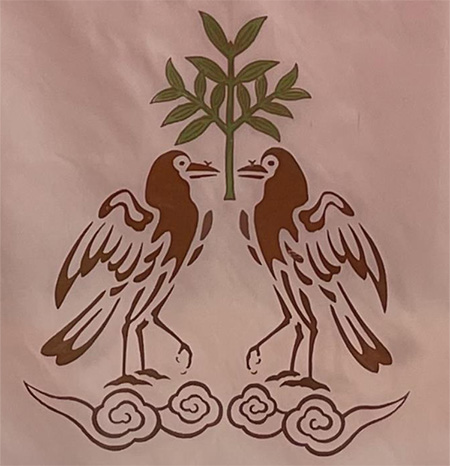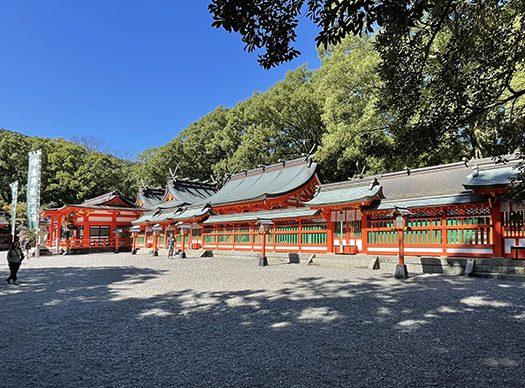


わたし自身の環境変化があってはじめて徐々に惹かれてきた流れがあったのですが、北海道に住む人間からすると「熊野」というのは本当に縁遠い。昨日も住宅関係の専門研究者で北海道出身のご高齢の方とお目にかかっていたのですが、「熊野・・・はぁ?」という反応。まぁそれが一般的な反応だろうと思います。
しかし、こうして熊野という地域文化、京都文化圏のなかでの位置付けなどを知るほどに、その主要な信仰ポイント「蘇(よみがえ)りの地」ということが近しく感じられる。高齢化を迎える年代の人間として、あらたな生き様を自分に問うような心理に向かわせていただける。人生のよみがえりと考えると、まことにありがたい日本の故事・故地だと心理が重なってくる。

さて、きのうまで2日間、熊野速玉大社の祖神「ゴトビキ」岩を祀る神倉神社について触れてきました。大社の由緒でも「神代の頃に、神倉山の磐座であるゴトビキ岩に熊野速玉大神と熊野夫須美大神が降り立ち、そこで祀られることとなった。 」と記されている。
祭神の熊野速玉大神は伊邪那岐神(イザナギ)とされ、熊野本宮大社では同じ神名で日本書紀に登場する速玉之男(はやたまのを)とされる。熊野夫須美大神は伊邪那美神(イザナミ)とされる。イザナギ・イザナミとすれば、国生み由来の祭神となる。
速玉之男については『日本書紀』の神話に登場する「唾」の神ともいわれる。〜絶命して黄泉国へ去った伊奘冉(イザナミ)を連れ戻しにいった伊奘諾は「見ないでくれ」といわれた彼女を見てしまい喧嘩して妻と別れることになった。その別れ際に唾を吐いた。その唾を吐く神をハヤタマノオとある。これに通じる話には失った釣り針を求めて海宮へいった山幸が、口に含んだ首飾りの玉とともに唾を容器の中に吐き入れると玉は容器から離れなくなった『古事記』の海幸山幸の神話。〜
これらは,唾を吐くことが契約を強固にするという発想を反映するものと考えられている。誓約の際に唾、爪などを相手に渡す習俗が海外にあることが知られるが、唾がわざわざハヤタマノオという名を与えられているのは、日本でこの習俗が強固だったことを示すという説。
・・・やはり人間と社会の始原的な動作・心理がその底流に存在して、ある種哲学的な示唆がそこにはあるのだと思える。神話という霧の中に示されていることがらだけれど、幾世代にもわたって「口承」として遺されてきた先人達の「叡智」がそこには秘められているのだと思う。
日本列島社会では、そういった人類知のようなものが、この熊野のように現代にまで建築的空間としてまで「つたわって」いることがわかる。
もちろん科学的・理性的に日常を処することは基本だけれど、やさしさのような部分ではこうした寛容につながる精神性を重視したいと思っています。
English version⬇
Shingu “Hayatama-taisha” Shrine for Kamikura – A Journey to Kumano and the Myth of the Imperial Family – 28
The name “Shingu” is derived from the architecture of this grand shrine. The traditions of the deities of the shrine are imbued with human knowledge and wisdom that transcend history. …….
I have been gradually attracted to Kumano only after a change in my own environment, but for those of us who live in Hokkaido, “Kumano” is a very remote place. Yesterday, I met an elderly researcher specializing in housing who is from Hokkaido, and his response was, “Kumano…what? I was meeting with an elderly housing researcher from Hokkaido yesterday, and his response was, “Kumano…huh? Well, I guess that is a common reaction.
However, the more I learn about the local culture of Kumano and its position within the Kyoto cultural sphere, the closer I feel to its main point of belief, “the place of revival. As a person of advancing age, the more I learn about Kumano and its place within the Kyoto cultural sphere, the more I feel closer to Kumano as a place of “revival,” a major point of faith in Kyoto. When I think of it as the revival of my life, I feel a sense of gratitude for this place, which is a very important historical event and place in Japan.
Until yesterday, I have been talking about Kamikura Shrine, which enshrines “Gotobiki” Rock, the ancestral deity of Kumano Hayatama-taisha Shrine. The shrine’s history also states, “During the Kami period, Kumano Hayatama and Kumano Husumi descended to Gotobiki Rock, a rock formation on Mount Kamikura, and were enshrined there. The shrine is described as “a place of worship for the god Kumano Hayatama.
Kumano Hayatama-O-no-kami, the deity of Kumano, is said to be Izanagi (Izanagi), while at Kumano Hongu Taisha, the deity is Hayatama no Ou, who appears in the Nihon Shoki (Chronicles of Japan) under the same name. Kumano-Osami-no-Okami is considered to be Izanami. If Izanagi Izanami is the deity of Kumano-Osumi, it would be the deity of the national birth.
Hayatama no Otoko is also said to be the god of “spit” in the myths of “Nihon shoki” (Chronicles of Japan). 〜When he went to bring back Izanami, who had died and left for Hades, he saw her, who told him not to look at her, and they quarreled and ended up separating. When they parted, he spat at her. The spitting god is said to be Hayatamanoo. In a similar story, Yamasachi went to the sea palace in search of his lost hook, and spit the spit into a container along with the ball of a necklace he had in his mouth. ~.
These are thought to reflect the idea that spitting strengthens the covenant. The fact that spit is given the name Hayatamanoo (spit is a symbol of the strength of the Japanese custom of giving spit, nails, etc. to the other party when making a covenant) is known from other countries.
… It seems to me that the primitive behavior and psychology of human beings and society exist at the bottom of the myth, and that there are certain philosophical implications. These things are shown in the mist of myths, but I believe that they contain the “wisdom” of our ancestors, which has been handed down orally for generations.
In the Japanese archipelago, we can see that such human knowledge has been “transmitted” to the present day as architectural spaces like this Kumano.
Of course, it is fundamental to deal with everyday life scientifically and rationally, but I would like to emphasize the spirituality that leads to such tolerance in areas such as gentleness.
Posted on 2月 1st, 2024 by 三木 奎吾
Filed under: 日本社会・文化研究







コメントを投稿
「※誹謗中傷や、悪意のある書き込み、営利目的などのコメントを防ぐために、投稿された全てのコメントは一時的に保留されますのでご了承ください。」
You must be logged in to post a comment.